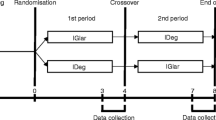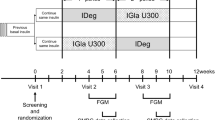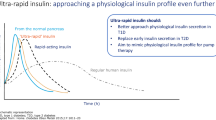Summary
Sixteen hospitalized insulin requiring diabetics treated with a single daily subcutaneous injection were randomly allocated either to a mixture of porcine Actrapid+Lente MC or a mixture of Regular+NPH—Biosynthetic human insulin (Study 1). In Study 2, 10 patients receiving two daily insulin injections were treated at random with either porcine Actrapid+Monotard, or Actrapid+Monotard—Semisynthetic human insulin or Regular+NPH—Biosynthetic human insulin. Once an optimal insulin regimen was obtained, circadian blood glucose and plasma free insulin profiles (7–9 time points) were determined with the two (Study 1) or three (Study 2) insulin preparations, keeping the doses of insulin constant. In Study 1 no significant difference in blood glucose (BG) or plasma free insulin (FIRI) profiles was observed. The mean daily blood glucose, the mean amplitude of glycaemic excursions (MAGE), the index of blood glucose control (M-value of Schlichtkrull), as well as the post-breakfast increases in blood glucose and mean free IRI, were similar with both types of insulin. In Study 2, BG and FIRI profiles were also similar, except for a significantly lower (p<0.02) BG at 8.30 p.m. with both human insulins. No significant differences were found in free IRI at that time. Mean BG, M index, MAGE and mean FIRI were similar but the postbreakfast increase was significantly smaller with SHI. In conclusion, the pharmacokinetics of animal monocomponent, semisynthetic and biosynthetic human insulin appear similar, but evening BG control was better with both types of human insulins given twice daily.
Similar content being viewed by others
References
Markusen J, Damgaard U, Pingel M, Snel L, Sørensen AR, Sørensen E (1983) Human insulin (Novo): chemistry and characteristics. Diabetes Care [Suppl 1]: 4–8
Chance RE, Kroeff EP, Hoffmann IA, Frank BH (1981) Chemical, physical and biologic properties of biosynthetic human insulin. Diabetes Care 4: 147–154
Owens DR, Jones MK, Hayes TM, Heding LG, Alberti KGMM, Homer PD, Burrin JM, Newcombe RG (1981) Human insulin: study of safety and efficacy in man. Br Med J 282: 1264–1266
Keen H, Glynne A, Pickup JC, Viberti GC, Bilous RW, Jarrett RJ, Marsden R (1980) Human insulin produced by recombinant DNA technology: safety and hypoglycaemic potency in healthy men. Lancet 2: 398–401
Nakagawa S, Nakayama H, Sasaki T, Yoshimo K, Yu Y, Shimoza KI, Aoki S, Mashima K (1973) Simple method for the determination of serum free insulin levels in insulin treated patients. Diabetes 22: 590–600
Heding LG (1975) Radioimmunological determination of human C-peptide in serum. Diabetologia 11: 541–548
Christiansen AH (1973) Radioimmunoelectroforesis in the determination of insulin binding to IgG. Methodological studies. Horm Metab Res 5: 147–154
Schoos R, Schoos-Barbette S, Lambotte C (1978) Dosage of hemoglobin A1c by isoelectrofocusing. Clin Chim Acta 86: 61–65
Schlichtkrull J, Munck O, Jersild M (1965) The M-value, an index of blood sugar control in diabetes. Acta Med Scand 177: 95–102
Service FJ, Molnar GD, Rosevear JW, Ackermann E, Gatewood LC, Taylor WF (1970) Mean amplitude of glycaemic excursions, a measure of diabetic instability. Diabetes 19: 644–655
Skyler JS (1982) Human insulin of recombinant DNA origin: clinical potential. Diabetes Care 5 [Suppl 2]: 181–186
Pickup JC, Bilous RW, Viberti GC, Keen H, Jarrett RJ, Glynne A, Cauldwell J, Root M, Rubenstein AH (1982) Plasma insulin and C-peptide after subcutaneous and intravenous administration of human insulin (recombinant DNA) and purified porcine insulin in healthy men. Diabetes Care 5 [Suppl 2]: 29–34
Kemmer FW, Sonnenberg G, Cuppers HJ, Berger M (1982) Absorption kinetics of semisynthetic human insulin and biosynthetic (recombinant DNA) human insulin. Diabetes Care 5 [Suppl 2]: 23–28
Botterman P, Gyaran H, Wahl K, Ermler R, Lebender A (1982) Insulin concentrations and time-action profiles of three different intermediate-acting insulin preparations in non diabetic volunteers under glucose-controlled glucose infusion technique. Diabetes Care 5 [Suppl 2]: 43–52
Colagiuri S, Kotowicz MA, Steinbeck AW, Kidson W (1983) Metabolic profiles in diabetic subjects treated with human insulin (Novo) and porcine insulin. Diabetes Care 6 [Suppl 1]: 49–52
Turner RC, Philips M, Jones R, Dornan IL, Holmes RR (1982) Ultralente-based insulin regimens in insulin dependent diabetics. In: Skyler JS (ed) Insulin update 1982. Excerpta Medica, Princeton, pp 157–174
Author information
Authors and Affiliations
Rights and permissions
About this article
Cite this article
Castillo, M., Nemery, A., Verdin, E. et al. Circadian profiles of blood glucose and plasma free insulin during treatment with Semisynthetic and Biosynthetic human insulin, and comparison with conventional monocomponent preparations. Eur J Clin Pharmacol 25, 767–771 (1983). https://doi.org/10.1007/BF00542517
Received:
Accepted:
Issue Date:
DOI: https://doi.org/10.1007/BF00542517




